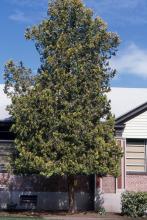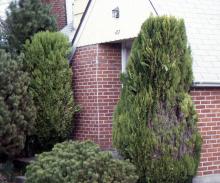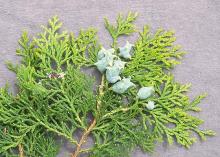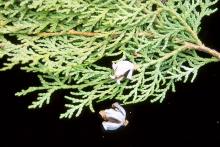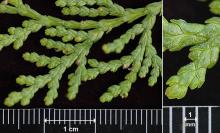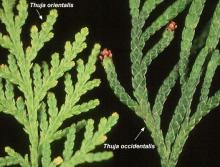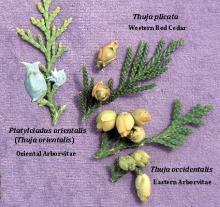Platycladus orientalis
Common name:
Chinese Arborvitae
Oriental Arborvitae
Pronunciation:
plat-ee-KLAD-us o-ree-en-TAH-lis
Family:
Cupressaceae
Genus:
Synonyms:
Thuja orientalis
Type:
Conifer
Native to (or naturalized in) Oregon:
No
- Conifer, evergreen shrub or tree, 4-6 ft (1.2-1.8 m) high, 3-5 ft (0.9-1.5 m) wide, [as a tree it may reach 40 ft (12 m) tall], dense, globular to ovoid, with branchlets held vertically and nearly parallel in arrangement. Bark thin, red-brown, separating into papery scales. Leaves scale-like, bright green but may turn brownish in winter, nearly alike on both sides, those on a main axis glandular, ending in a free spreading point. Cones ovoid, 1.5-2.5 cm long, fleshy, blue before they mature, scales thick and hooked.
- Sun. Tends to open up with age, and may have to be tied.
- Hardy to USDA Zone (5)6 Native to Korea, Manchuria and northern China.
-
Many named selections (cultivars) have been developed from this species; Krüssmann (1985) lists over 30. Here are a few more:
- 'Franky Boy' - dwarf shrub, rounded, teardrop shape, with fine tread-like branches
- 'Morgan' - dwarf shrub, yellowish foliage, turns orange in winter
- 'Van Hoey Smith' - upright shrub, somewhat loose, yellow-gold variegation, slow growing
- Taxonomy: This species at one time was classified as Thuja orientalis, but now there is general consensus that it does not belong in the Thuja genus and has been transferred to the genus Platycladus, hence Platycladus orientalis. However, some horticultural nurseries and retail outlets continue to use the older designation.

